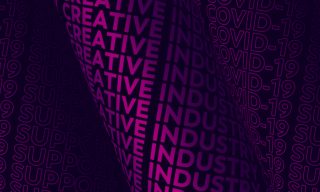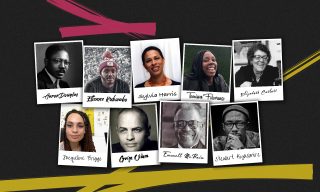Looking for design inspiration? We round up our favourite must-reads and the creative a-ha moments we took away from them.
We’re big fans of t’internet at stuff, with loads and loads of websites at the tips of your fingers, you can get information on pretty much anything from pretty much anywhere nowadays. However, we’re going to give some love to our paper pals and say that you just can’t beat a good design book. The thing about these books is that even as the years go on, their knowledge is timeless – just like good design, funnily enough. So apart from fulfilling our love of print and making our nostrils happy (fun fact: after some time, paper starts smelling like vanilla) we’ve learned some invaluable knowledge nuggets from these pages. So without further ado, we round up our must-reads for designers (and creative folk in general).
Just My Type – Simon Garfield
What it’s good for:
This book’s great when looking for inspiration, as it’s filled with examples of different typefaces, letters & glyphs in an easily digestible way – Simon frequently references the font’s he’s talking about throughout the book, so it doesn’t become one of those ones where you need to flip back to the beginning every five pages. We’ve learned loads of ‘did you know?’ facts from this book; London Underground font is Johnston Sans, about the controversy of IKEA changing to Verdana from Futura and having a real appreciation for the typographic perfection of our road signs (the typeface Transport designed by Margaret Calvert and Jock Kinneir in the 60s). One of those ones that any creative can delve into and learn something.

Logo Modernism – Jens Muller
Logo Modernism is about the sheer persuasive power of good form for corporate identity and is basically a big encyclopedia designs from 1940-1980. As a bunch of self-confessed brand geeks, this book is the stuff of reference dreams and one that we pull out time and time again – you’d be surprised by how many familiar trends (and logos) you see repeating even today.
What it’s good for:

Design Your Life: Applying Design Principles to Your Life – Vince Frost
This book is about Vince Frost’s lifetime of designing everything except himself and why he changed that. It’s a book that’s not solely about the finer details of design, but a broader look at problem solving, where Vince (former Creative Director of Pentagram and now Owner of Frost*collective) tackles his toughest brief to date. He’d spent years solving other’s problems and finding solutions for clients, while his own life, health and happiness slipped out of control. Treating himself like a client, he designed his way up and out from rock bottom.
What it’s good for:
Not pointing any elbows, but we know a few designers who spend a lot of time in from of a computer, which is great for some things, but not a great way to spend all-day, every day. We tend to pull out this book when we need a boot up the backside and for some inspiration too. With great use of colour, language and typography, Vince takes you along his journey in a way that’s pleasing to the eye, the brain and the fire in your belly too.

Ways of Seeing – John Berger
An oldie, but goodie – Ways of Seeing by John Berger has inspired generations of designers and creatives for decades. Based on the BAFTA winning BBC television series of the same name (check those 1970s lapels) the book’s all about the way we view art and how we process information before we articulate it – if you think about it, babies see before they can speak, and even as we grow up, seeing plays a huge part in how we communicate with everything.
What it’s good for:

A Technique for Producing Ideas – James Webb Young
A Technique for Producing Ideas is a tiny 30-something page book with a 5 step technique to coming up with ideas. It’s all about sparking creativity in everyone, even those who wouldn’t necessarily consider themselves as creative – everyone has a creative streak, it’s just a case of thinking a certain way to approach a problem (or brief) in a way that unlocks great ideas.
What it’s good for:
Short, concise and to the point, this book is a must-read for people in the creative, or any industry for that matter. If you’ve ever reached the point where you feel like your head is a big ball of Playdoh, this paperback wonder is just the ticket to gathering all of your thoughts and getting back on track to your lightbulb moment. Originally published in 1940 (a very oldie, but very goodie) its principles still apply today as much as they did way-back-when – our bookshelf wouldn’t be complete without it.

What do you guys think?
You didn’t think we were going to write a blog post about favourite books and not ask you lot, did you? So, we took to Twitter for an insight on the creative books that get your brains ticking. Pssst – if you’d like to add to the list, tweet us @MadeBrave (don’t be shy, you brilliant creative mind, you).
Creative folk assemble! We’re writing a blog post about must-read books for designers. Any we should mention?
— MadeBrave® (@MadeBrave) May 3, 2016
@MadeBrave @michaelbierut‘s How to. There’s a great section on how Theresa LePore is the most influential designer of the 21st century.
— Colin (@MadaNiloc) May 3, 2016
Hi check out any book,course by @jeanneliedtka #designthinking at its best. https://t.co/eWB07wqmRI — Douglas Maxwell (@DouglasMaxw3ll) May 3, 2016
@MadeBrave And there’s a Smile n the Mind… and the Art of looking sideways… and… the list goes on — David Hunt (@iamdavidhunt) May 3, 2016
.@MadeBrave Daring Greatly by the incredible @BreneBrown for a life-changing look at vulnerability and how it affects our creative work!
— Shelley (@Shelley_Oh) May 3, 2016
@MadeBrave Logo Design Love by @DavidAirey is a great one to check out!
— Shannon Lavery (@ShannonLavery93) May 3, 2016
@MadeBrave E by Matt Beaumont! Hilarious! — Laura Kelly (@LauraKelly__) May 3, 2016
Do/ Purpose by @davidhieatt is brilliant @MadeBrave https://t.co/IHDgLRUHZ5 — stewart ainslie (@stewartainslie) May 4, 2016
@MadeBrave The Art of Looking Sideways, Understanding Comics, and the Design of Everyday Things are all classics.
— UX Glasgow (@uxglasgow) May 4, 2016
@uxglasgow @MadeBrave Also “Don’t Make Me Think” by Steve Krug
— martin_godfrey (@martin_godfrey) May 4, 2016
@MadeBrave UX Strategy by @JaimeRLevy is so helpful and insightful.
— Angus Carbarns (@AngusCarbarns) May 4, 2016



